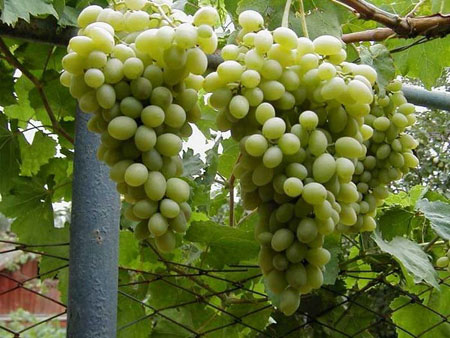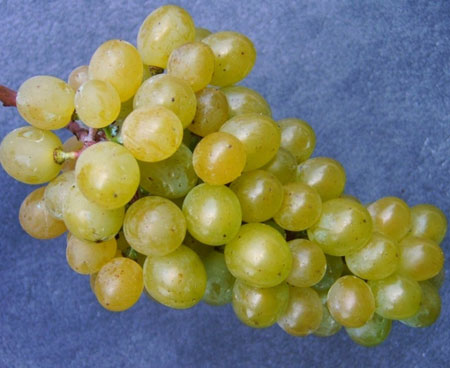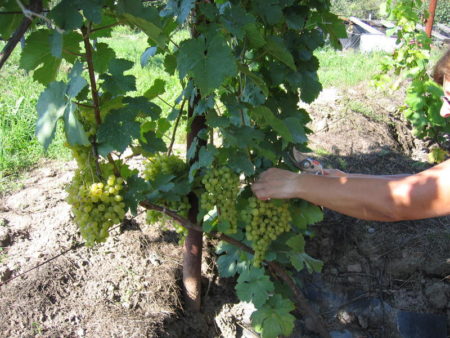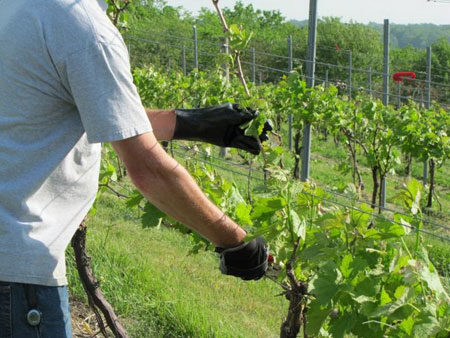Everyone knows that grapes are a thermophilic southern plant. But there are also varieties that grow well and bear fruit. in the northern latitudes of our homeland. These include Moscow White. It withstands frosts to minus 30 degrees.
Content
Grade Features
Grapes "Moscow White" is a hybrid of two popular varieties - "Amur White" and "Pearl sub." He inherited frost resistance and high fruitfulness from his parents. Although the variety does not belong to large-fruited, it is very popular among amateur winegrowers.

Not a sissy - unpretentious in leaving. Frost-resistant, withstands harsh winters of central Russia. It does not require shelter. Its vine-like vine is suitable for landscaping arches, arbors. Very fertile. In one season, up to 35 kg of berries are obtained from the bushes. One bush gives up to 6 kg of fruit.
Moscow White is an early ripe variety. Harvest can be removed in mid-August. The fruits, although not large, have a bright pleasant taste. Ripe clusters persist for a long time. Suitable for long transportation.
However, for commercial purposes, grapes are practically not grown. It mainly grows in suburban areas. Berries are used fresh. Of these, compotes and preserves are also boiled. An interesting variety for winemakers. From the berries you get a good homemade wine.
Culture Description
Adult vine bushes are well developed. They have good branching, which allows them to wrap around arbors and arches. They have a thin light brown bark. Branches withstand significant loads. The leaves are wide, carved, five-fingered. They have pronounced veins. On the inside grows a small fluff, similar to cobwebs. The color of the leaves is bright green.
The flowers are bisexual, do not require additional pollination. "Moscow White" is often planted near plants with female flowers for additional pollination. Small berries, reach 5 g of weight. They have a rounded or slightly oblong shape. The color of the berries is light green. Ripe fruits take on a golden hue.
The pulp is strong, crispy. The taste is bright, sweet with a slight acidity. There are 2-3 stones, which are well separated from the pulp. The clusters are cone-shaped, slightly loose. When ripening, they usually weigh about 250 g. But with good care of the vineyard, their weight increases to 400 g.
It should be remembered that ripened grapes must be removed immediately. It is not recommended to leave ripe clusters on branches. This is necessary to give young shoots woody. Otherwise, they will not have time to get stronger and will freeze during the first frost.
Pros and cons of the variety
 Moscow White has all the qualities to be popular. Amateur winemakers appreciate him for:
Moscow White has all the qualities to be popular. Amateur winemakers appreciate him for:
- high fertility;
- resistance to severe climate;
- frost resistance;
- early ripening;
- good keeping quality of bunches;
- delicious berries;
- universality of use;
- resistance to mildew, gray rot, oidium.
However, the variety has a drawback - poor resistance to fungal diseases. Resistance to them in grapes is approximately 60%. The sultry period is especially dangerous when the air temperature rises above 26 degrees.
To prevent diseases, it is necessary to spray the plant and soil at the roots in the heat with special preventive solutions. And if the bush is still sick, remove the infected leaves and berries, and treat it.
Agricultural technology of culture
To obtain a good grape harvest, the following agricultural activities are mandatory.
Kilchevany
In order for the culture to develop strong and stable roots before planting, it is necessary to stitch shoots. Preliminary shoots inspected. Choose those that do not have traces of rot and drying.
From both ends the shoots are pruned. At the cut, they should have a green tone. Cut one centimeter below the knot. The lower kidney is removed. Shoots are soaked in clean, warm water. This must be done 55-60 days before planting.
Before soaking, water is preliminarily prepared. Charcoal is poured onto the bottom of the can. Lining the bottom with cotton wool. Pour pure water from above. With this approach, there is no need to change the water too often. It is updated every 10 days.
At the ends of the shoots with a knife, make several grooves and lower them into the water. The jar is exposed in the sun. While kilchivanie passes it can not be rearranged in a cool place. Water temperature should not be lower than 20 degrees.
Landing Features
 Despite frost resistance, grapes love the sun. Therefore, you need to plant it on the south side of the site. For planting seedlings, it is better to choose a place on a hill, near the wall of a house or a barn. Then the plant will be protected from strong gusts of wind.
Despite frost resistance, grapes love the sun. Therefore, you need to plant it on the south side of the site. For planting seedlings, it is better to choose a place on a hill, near the wall of a house or a barn. Then the plant will be protected from strong gusts of wind.
Moskovsky White feels bad in shaded areas. Even with abundant flowering, you are unlikely to wait for berries. If you plant it in a lowland, the water will stagnate at the roots. Culture will often ache and wither from mildew.
The variety loves light acidic soil. Therefore, acidic chernozems are suitable for it. On calcareous soils poorly developed. To improve the condition of the land allotted for the vineyard, add strongly acid peat.
To ensure loosening of the soil, gravel or broken brick is poured into the bottom of pits or ditches. Tamping it, lay a layer of turf on top. Then, earth mixed with organic fertilizers is added to the pit. For this, rotted manure or compost is suitable. Potassium phosphorus fertilizers are also added.
Pits are dug to a depth of 60 cm. After laying all the layers in the middle, place a seedling and cover it with earth. Tamp lightly, water and mulch. The grapes are planted in the ground at the end of May.
With good care, young bushes begin to bear fruit in the third year of life. If you plant the grapes in the wrong place, the plant will grow slowly. Harvest will have to wait a long 4-5 years.
When landing, observe the distance. From future bushes to the nearest trees, it should be at least half a meter, since the roots of garden trees can greatly dry the soil around the vineyard. The distance to the wall of the house should be at least half a meter. Between the rows - 2.5 m.
The variety is well adjacent to gooseberry and currant bushes. They can be safely planted in the aisle. Since the bushes are powerful, they need support. To do this, between the pits for seedlings drive high wooden poles and stretch the wire.
"Moscow White" propagated exclusively by seedlings. When landing, you need to pay attention to the appearance. At the cut, seedlings should be green, have two to three developed rhizomes. Stems reach a length of at least one meter.
Features orbeski
Grapes do not require careful care. Nevertheless, you need to take care of him. Pruning is done twice a year. In the autumn, before wintering, the vines are pruned, leaving 4-8 eyes. In the spring, when snow is falling, pruning is carried out again to remove frozen shoots.
In the process of increasing the green mass of the leaf, green growth is thinned out. Unscrew the extra leaves so that 15-16 leaves are left over the bunch. Before the formation of the ovary, stepsoning is carried out. Remove excess shoots that interfere with fruiting.
Fertilizer application
In order for the grapes to develop normally and bear fruit well, root and foliar top dressings are introduced:
- in the spring the soil is fertilized with mineral fertilizers;
- in the summer season, ammonium nitrate is introduced until the fruit ripens;
- during the year - magnesium as an extra root top dressing to increase the immunity of the vine.
The plant is fertilized in several stages:
- when young shoots grow to 15 cm;
- two weeks after flowering;
- on the eve of ripening berries.
Watering
In the first year of development, the culture is watered in cloudy weather once a week, in heat - every other day. In the second year, plants are watered once a week, regardless of weather conditions. Adult bushes do not water at all.
So that the soil remains at the roots always moist, it is constantly loosened. Weeds are pulled out and mulched. As a mulch straw, dry moss, wood chips are excellent. It is necessary to monitor that the soil retains moisture at a depth of half a meter under the root system.
Wintering
Although the variety is considered uncultivated, many amateur growers still cover it. Indeed, in winter frosts are possible up to minus 35-40 degrees. Then not only the vine, but also the root system of the culture will suffer.
Shelter in two ways. They press the vine to the ground and sprinkle with soil 40-50 cm. The second method is covering with spruce branches. To do this, pine or spruce branches are laid on top of the vine. This method is very good. Grapes tolerate even the most severe frosts.
Diseases and Pests
 Moscow White has immunity against a number of fungal diseases. But in the heat of more than 26 degrees, his resistance to disease falls. A fungus can hit him.
Moscow White has immunity against a number of fungal diseases. But in the heat of more than 26 degrees, his resistance to disease falls. A fungus can hit him.
Therefore, in hot weather, prophylactic spraying of culture branches with solutions of copper sulfate or one percent Bordeaux mixture should be carried out. Procedures are carried out every one and a half weeks, as the funds are washed off by rain.
If grapes were sick last year, such sprayings are especially useful. They help to heal wounds on the stem parts of plants, destroy hidden insects and their eggs. Prevention is carried out until the flowering culture. After flowering, they resume and stop only 3-4 weeks before fruiting.
To combat dangerous insects, many amateur growers plant parsley in the rows between grapes. Green parts of a garden plant repel insects. Moreover, such a neighborhood does not harm either culture or parsley itself. Both types of plants grow well and bear fruit.
Reviews of amateur winegrowers
Gennady, 52 years old
I have been growing grapes for 12 years. I consider the Moscow White variety to be the most unpretentious. Many do not want to mess with him because of the instability to diseases. But I declare - it’s okay. Even if the plant loses all the leaves, the clusters remain and ripen. I did not notice the cluster diseases. The berries of the grapes are very tasty, juicy. Suitable for wine.
Vladimir, 47 years old
I really like this variety for its frost resistance. It withstands severe frosts even without shelter. But just in case, I cover him with spruce branches. Winters much easier than other varieties. After the winter, I cut off the frozen branches. But there are few of them. Basically, the plant tolerates our harsh winters well.
Nadezhda, 35 years old
Moscow White was enjoyed by our entire family.Not only is the variety unpretentious and grows without much care. Its berries are very tasty. The pulp is dense, crispy. I cook compotes from grapes for the winter. The husband makes wine from berries. Very sweet berry with a little playful sourness.
Moscow White attracts many amateur growers. He not only tolerates all adverse weather conditions. Its fruits are also extremely tasty and fragrant. Perhaps the best variety that would grow in the north is difficult to find.




 Non-covering winter-hardy grape varieties for Moscow region
Non-covering winter-hardy grape varieties for Moscow region How to keep the vine in winter
How to keep the vine in winter When can I transfer grapes to another place in the fall
When can I transfer grapes to another place in the fall How to cover and prepare grapes for the winter in the suburbs
How to cover and prepare grapes for the winter in the suburbs